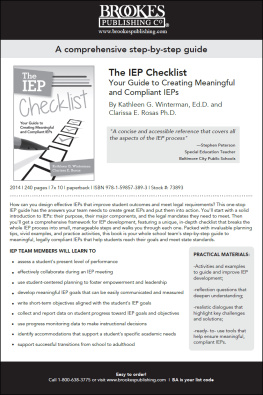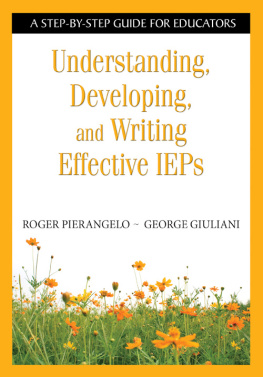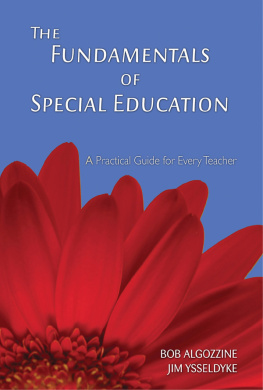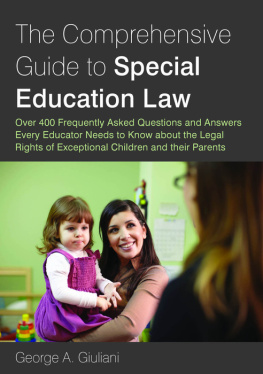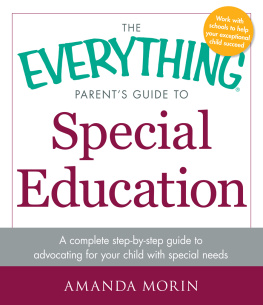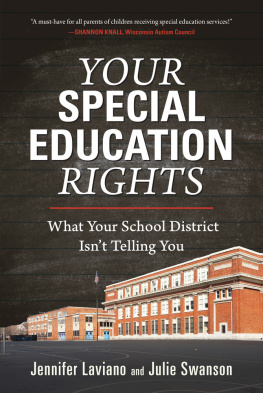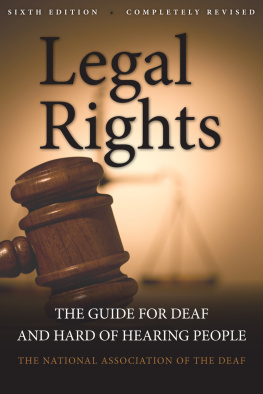The EverydayGuide to Special Education Law
A Handbook for Parents,Teachers and Other Professionals By Randy Chapman, Esq.
Copyright 2008 The LegalCenter for People with Disabilities and Older People, 455 ShermanStreet, Suite 130 Denver, Colorado 80203
All rights reserved. No partof this book may be reproduced or transmitted in any form or by anymeans, electronic or mechanical, including photocopying, recordingor by any information storage and retrieval system, without writtenpermission from The Legal Center, except for the inclusion of briefquotations in a review.
Smashwords Edition, License Notes
This ebook is licensed for your personalenjoyment only. This ebook may not be re-sold or given away toother people. If you would like to share this book with anotherperson, please purchase an additional copy for each person youshare it with. If youre reading this book and did not purchase it,or it was not purchased for your use only, then you should returnto Smashwords.com and purchase your own copy. Thank you forrespecting the hard work of this author.
This publication is designedto provide accurate and general information in regard to thesubject matter covered. It is sold with the understanding that theauthor and the publisher are not engaged in rendering legal orother professional services. If specific legal advice is required,please consult an attorney.
Second Edition
Table of Contents
What Is a Free Appropriate PublicEducation?
Who Are Children with Disabilities?
What Is Special Education?
What Are Related Services?
Medical Services Versus Related Services
What Are Supplementary Aids and Services?
What Are Assistive Technology Devices andServices?
Extended School Year
School Records and Confidentiality
II. Least Restrictive Environment
The Courts and LRE
Supplementary Aids and Services
LRE and the IEP
Initial Evaluation
Referral for Initial Evaluation
Consent
Screening
Evaluation Process
Specific Learning Disabilities
Severe Discrepancy Standard
Attention Deficit Disorder and AttentionDeficit Hyperactivity Disorder
Re-evaluation
Summary of Performance
Independent Educational Evaluations
Who Are the Members of the IEP Team?
Team Absences
What Are the Components of the IEP?
Developing the IEP and Special Factors
Transfer Students
Transfer Within the Same State
Transfer from Outside the State
Transition Services
Specific Services
Reviewing, Revising, and Amending the IEP
Amending the IEP
Using the IEP Process
Hints for Parents
Hints for Educators and Other Members of theIEP Team
Conclusion
The IEP Process
Informal Dispute Resolution Procedures
Procedural Safeguards
Prior Written Notice
Procedural Safeguards Notice
Surrogate ParentS
Impartial Due Process Hearings
Due Process Complaint Notice
Response to the Due Process Complaint Notice.
Response to the Specific Issues Raised inthe Due Process Complaint Notice
Sufficiency of the Due Process ComplaintNotice
Amending the Due Process ComplaintNotice
Mediation
Resolution through Mediation Is LegallyBinding
Mediation Means Finding a Middle Course
Resolution Session
Resolution Session Settlement Agreement
Impartial Due Process Hearing
Hearing Issues
Timeline for Requesting a Hearing
Rights in the Hearing Process
Burden of Proof
Qualifications of the Hearing Officer
Timeline for Hearing Officer Decision
Appeal ProcesS
Administrative Appeal
Civil Action
Attorneys Fees.
The Stay-put Rule
State Education Agency Complaint Process
Filing a Complaint with the State EducationAgency
Thoughts and Hints about DisputeResolution
Dispute Resolution Timeline
Discipline Overview
Manifestation Determination
Provision of Educational Services
Functional Behavioral Assessment
Authority of School Personnel
Special Circumstances
Manifestation Determination
The Manifestation Determination Process
If the Behavior Is a Manifestation of theStudents Disability
If the Behavior Is Determined NOT to Be aManifestation
of the Students Disability
Interim Alternative Educational Setting
Appeals and Procedural Safeguards
Notice
Disciplinary Appeal Process
Expedited Hearings and the Authority of theHearing Officer
Expedited Hearing Timeline
Authority of the Hearing Officer
Placement during Disciplinary Appeals
What About Children Who Havent BeenDetermined
Eligible for Special Education?
What Happens If the School District Does NotKnow the Student Has a Disability?
What If the Parent Requests that the StudentBe Evaluated after the Student Is in the Disciplinary Process?
What To Do If Your Child Is Suspended
Private School Placements by the PublicSchools
Private School Placements by Parents
Because the Public School Program IsInappropriate
Students Whose Parents Choose Private SchoolPlacement
Child Find
Service Coordination and Planning
Services Plalns for Parentally-placedPrivate School Children with Disabilities
Appeal Process for Parentally-Placed PrivateSchool Children
What Is a Free Appropriate Public Educationunder Section 504?
Who Is a Person with a Disability under504?
Examples of 504 Accommodations
Evaluation under Section 504
Standardized Assessments
Assistive Technology and Section 504
Discipline and 504
Procedural Safeguards under Section 504
The Americans with Disabilities Act
Title III and Private Schools
Disability Harassment
Retaliation
Community Access
Filing Complaints With the Office For CivilRights
Infant or Toddler with a Disability
Early Intervention Services
Part C Service Providers
Natural Environments
Individualized Family Service Plan
Content of the Individualized Family ServicePlan
Parent Consent
Service Coordinator
Transition from Part C Early InterventionServices
Procedural Safeguards
Stay-put
Conclusion
I wrote this book primarilyto help students, parents, advocates, and other professionalsbetter understand the Individuals with Disabilities Education Act(IDEA). Congress, most recently, amended the IDEA in 2004.Subsequently, the Department of Education adopted regulationsimplementing the IDEA 2004 that were effective July 5, 2006. Thisedition of The Everyday Guide addresses the major changes in theIDEA 2004 including references to the Department of Educationregulations. The IDEA statute is very detailed and, for the mostpart, the regulations follow the statute without adding muchclarification. So, I have only referred to the regulations where Ithought they provided additional information or clarified thestatute. I have also tried to make the law a little lessconfusing.
By saying I wrote this bookprimarily for students, parents, and advocates, I dont mean thatit isnt also intended for teachers and other educators. Mostteachers and educators advocate for children with disabilities, ingeneral, and their own students, in particular. They just advocatefrom within the educational system. So, while the book is writtenfrom a parent perspective, the information is also intended to helpthose who have answered the call to become a member of that mosthonorable of professions, teachers.
This book is not intendedto be a legal treatise on special education case law. The book ismeant to be an everyday guide to special education law to helpparents, advocates, students with disabilities, and educators tounderstand the basic requirements of the IDEA, Section 504 of theRehabilitation Act of 1973 and Title II of the Americans withDisabilities Act.


